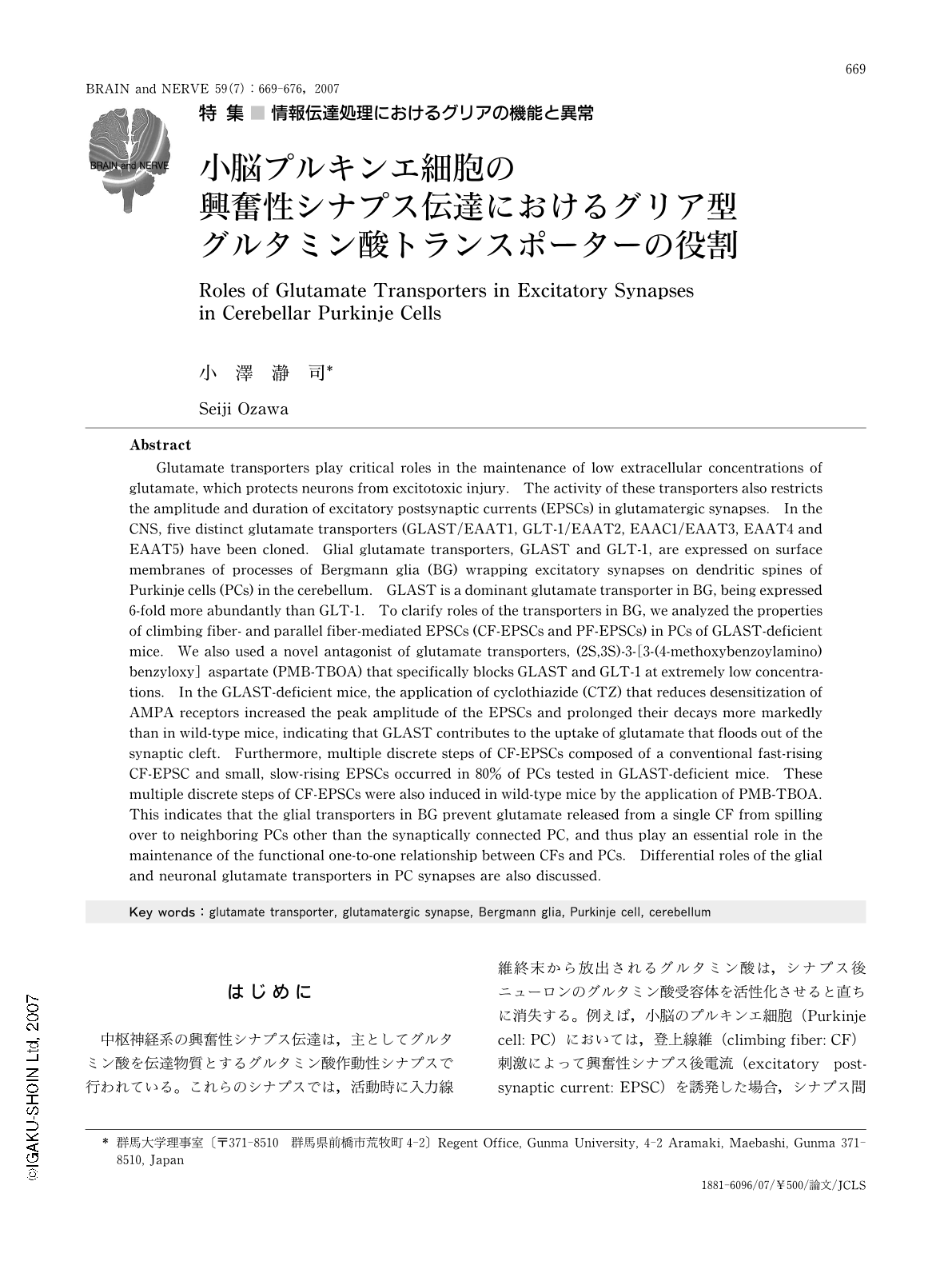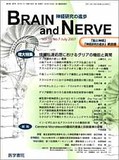Japanese
English
- 有料閲覧
- Abstract 文献概要
- 1ページ目 Look Inside
- 参考文献 Reference
はじめに
中枢神経系の興奮性シナプス伝達は,主としてグルタミン酸を伝達物質とするグルタミン酸作動性シナプスで行われている。これらのシナプスでは,活動時に入力線維終末から放出されるグルタミン酸は,シナプス後ニューロンのグルタミン酸受容体を活性化させると直ちに消失する。例えば,小脳のプルキンエ細胞(Purkinje cell: PC)においては,登上線維(climbing fiber: CF)刺激によって興奮性シナプス後電流(excitatory postsynaptic current: EPSC)を誘発した場合,シナプス間隙のグルタミン酸濃度は,静止時の数μM以下から急激に9~12mMまで上昇し,数ミリ秒以内に元のレベルに戻る1)。この際のグルタミン酸の消失は,拡散とグルタミン酸トランスポーターによる取り込みによっており,後者の機能の低下はシナプス間隙へのグルタミン酸の貯留をもたらし,興奮性シナプスにおける情報伝達のシグナル・ノイズ比を減少させ,場合によってはグルタミン酸によるニューロンの過剰興奮,さらには興奮毒性(excito-toxicity)によるニューロン死を招くことになる。
グルタミン酸トランスポーターは細胞形質膜,ミトコンドリア,シナプス小胞に存在するが,ここではグリアまたはニューロンの形質膜上に存在するトランスポーターについて論ずる。このトランスポーターは,Na+依存性にグルタミン酸の高い濃度勾配(細胞外では数μM,細胞内で約10mM)に逆らって,グルタミン酸を細胞外から細胞内に移送する役割を持つ。現在までに,このようなグルタミン酸トランスポーターには,excitatory amino acid transporter 1(EAAT1またはGLAST),EAAT2(GLT-1),EAAT3(EAAC1),EAAT4,EAAT5の5種類のサブタイプの存在が知られている2,3)。このうち,EAAT5は網膜のみに,他の4種類は中枢神経系に分布し,GLASTとGLT-1はグリアに,またEAAC1とEAAT4はニューロンに存在する。
本稿では,小脳のCFおよび平行線維(parallel fiber: PF)終末がPCと形成するグルタミン酸作動性シナプスにおけるグルタミン酸トランスポーターの役割について,特に,PCと密接な関係にあるベルクマングリア(Bergmann glia: BG)との機能連関という観点を中心に述べてみたい。
Abstract
Glutamate transporters play critical roles in the maintenance of low extracellular concentrations of glutamate, which protects neurons from excitotoxic injury. The activity of these transporters also restricts the amplitude and duration of excitatory postsynaptic currents (EPSCs) in glutamatergic synapses. In the CNS, five distinct glutamate transporters (GLAST/EAAT1, GLT-1/EAAT2, EAAC1/EAAT3, EAAT4 and EAAT5) have been cloned. Glial glutamate transporters, GLAST and GLT-1, are expressed on surface membranes of processes of Bergmann glia (BG) wrapping excitatory synapses on dendritic spines of Purkinje cells (PCs) in the cerebellum. GLAST is a dominant glutamate transporter in BG, being expressed 6-fold more abundantly than GLT-1. To clarify roles of the transporters in BG, we analyzed the properties of climbing fiber- and parallel fiber-mediated EPSCs (CF-EPSCs and PF-EPSCs) in PCs of GLAST-deficient mice. We also used a novel antagonist of glutamate transporters, (2S,3S)-3-[3-(4-methoxybenzoylamino)benzyloxy]aspartate (PMB-TBOA) that specifically blocks GLAST and GLT-1 at extremely low concentrations. In the GLAST-deficient mice, the application of cyclothiazide (CTZ) that reduces desensitization of AMPA receptors increased the peak amplitude of the EPSCs and prolonged their decays more markedly than in wild-type mice, indicating that GLAST contributes to the uptake of glutamate that floods out of the synaptic cleft. Furthermore, multiple discrete steps of CF-EPSCs composed of a conventional fast-rising CF-EPSC and small, slow-rising EPSCs occurred in 80% of PCs tested in GLAST-deficient mice. These multiple discrete steps of CF-EPSCs were also induced in wild-type mice by the application of PMB-TBOA. This indicates that the glial transporters in BG prevent glutamate released from a single CF from spilling over to neighboring PCs other than the synaptically connected PC, and thus play an essential role in the maintenance of the functional one-to-one relationship between CFs and PCs. Differential roles of the glial and neuronal glutamate transporters in PC synapses are also discussed.

Copyright © 2007, Igaku-Shoin Ltd. All rights reserved.


